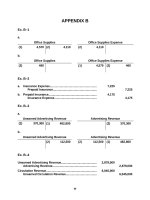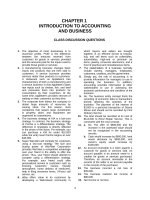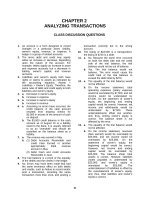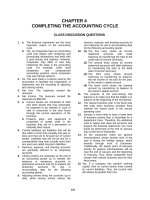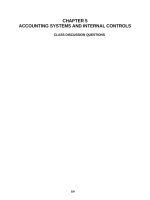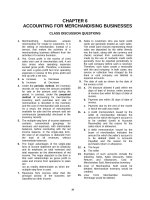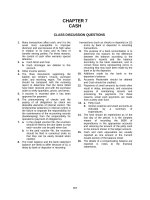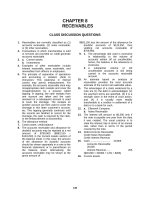Solution manual investments 10th by jones ch04
Bạn đang xem bản rút gọn của tài liệu. Xem và tải ngay bản đầy đủ của tài liệu tại đây (149.25 KB, 11 trang )
Chapter 4:
Securities Markets
CHAPTER OVERVIEW
Chapter 4 is designed to cover the markets where
financial assets trade, with particular emphasis on equity
markets. This chapter is a followup to Chapter 2 which
discussed the financial assets available to investors
through direct investing, with primary emphasis on
marketable securities.
Primary markets are discussed at the outset of the
chapter for completeness and as a contrast to secondary
markets, which are the main focus of Chapter 4. Investment
banking functions are considered, with a detailed discussion
of the underwriting function. New trends in investment
banking also are covered, including the shelf rule and the
unsyndicated stock offering. Global investment banking is
analyzed because of its increasing importance.
Chapter 4 provides an analysis of the structure of
secondary markets, with securities organized by where they
are traded. Terminology is explained, and the functioning
of the markets, primarily the NYSE and Nasdaq, are
considered in some detail. Because of the increasing
importance of Nasdaq, it is given special attention. It is
recommended that instructors spend some time developing the
differences between the NYSE and Nasdaq, and discuss the
possible future forms that markets may assume.
Chapter 4 includes brief discussions of bond markets
and derivatives markets, both of which are considered in
more detail in their respective chapters. Foreign markets
are discussed in some detail so that students will have some
idea of what is happening around the world. New trends are
analyzed, such as "in-house" trading by institutional
investors.
This chapter also contains a discussion of major market
indices, including the Dow Jones Averages, the S&P Indexes,
and brief descriptions of Amex, Nasdaq, and foreign stock
indices. This discussion has been expanded from the 7th
edition. Appendix 4-A contains more details on the
construction and composition of these market indicators.
37
The chapter contains a discussion of the changing
securities markets. This begins with the stimulus for the
many changes that have transpired in recent years-institutional pressure and the Securities Acts Amendments of
1975--and ends with the current and projected status of the
markets. An up-to-the-minute analysis of the changing
nature of Wall Street is presented here, including the
globalization of securities markets and the NYSE’s role in
the global marketplace. Obviously, the
structure of the securities markets continues to change, and
instructors can update developments as they choose.
CHAPTER OBJECTIVES
To explain primary and secondary markets in terms of
their components and organizational structure.
To explain terminology (e.g., broker, specialist, and
so forth) pertaining to markets and participants.
To emphasize the structure and functioning of the
secondary markets, with emphasis on the NYSE and
Nasdaq.
To discuss the changes that have occurred in the
secondary markets and that may occur in the next few
years.
38
MAJOR CHAPTER HEADINGS [Contents]
The Importance of Financial Markets
[allocationally efficient vs. operationally efficient]
The Primary Markets
[IPOs]
The Investment Banker
[definition; what they do; underwriting, syndicate,
prospectus; shelf rule; role of analysts in touting
stock]
Global Investment Banking
[managing the global offering; privatization]
Private Placements
[advantages and disadvantages of private
placements]
The Secondary Markets--Equities
Auction Markets
[NYSE; specialists; ASE; regional exchanges]
Negotiated Markets
[NASD; Nasdaq; Nasdaq/NMS]
Electronic Communications Networks (ECNs)
[definition; examples of ECNs; Instinet; in-house
trading]
In-House Trading
Foreign Markets
[description of many foreign markets; relative sizes]
Comparisons of Equity Markets
[share volume for all U. S. equities markets, and
dollar volume of equity trading in major world markets]
Stock Market Indicators
39
[Dow Jones; S&P; Amex; Nasdaq; relationships; foreign
markets]
Other Secondary Markets
Bond Markets
[the trading of each of the four major types of bonds]
Derivatives Markets
[where options and futures trade]
The Changing Securities Markets
[the stimulus for market changes; national market
system; inter-market trading system; other changes]
The Globalization of Securities Markets
[new trends on Nasdaq and the exchanges; the NYSE's
role in the global marketplace]
Appendix 4-A
Stock Market Indices
POINTS TO NOTE ABOUT CHAPTER 4
Tables and Figures
Table 4-1 is new for the 8th edition. It illustrates
how a value-weighted index is constructed and calculated.
This methodology applies to most indexes such as the S&P 500
Index.
Figure 4-1 is useful for illustrating the underwriting
process in a simple manner. It shows at a glance the major
steps in the underwriting process.
Figure 4-2 organizes the secondary markets by type of
security. It is based on a three-part classification of
equities, bonds, and puts and calls.
Figure 4-3 is new for the 8th edition.
some basic facts about the NYSE.
40
It contains
Figure 4-4 is new for the 8th edition. It is part of
the NYSE website and discusses the role of both brokers and
specialists.
Figure 4-5 shows a comparison of number of companies
traded for the NYSE, Amex, and Nasdaq. Nasdaq, of course,
dominates in terms of number of companies traded. Both
Nasdaq and the NYSE completely dominate the Amex.
Figure 4-6 shows a comparison of share volume for
Nasdaq, NYSE, and Amex. Nasdaq is the volume leader, with
some 62 percent of total shares traded in 2000.
Boxed Inserts
Box 4-1 is taken from Business Week and discusses
after-hours trading. This is relevant in today’s world
because of the significance of the ECNs.
41
ANSWERS TO END-OF-CHAPTER QUESTIONS
4-1.
Financial markets are essential for both businesses
and governments in raising capital to finance their
operations. Both experience demands for funds that
are not in balance with their actual funds on hand.
Financial markets are absolutely essential to the
functioning of our capitalistic economy.
Technically, primary markets can exist without
secondary markets since new securities can be sold
to investors. For example, bonds could be sold to
institutional investors to be held until they
mature. However, investors would have difficulty
reselling these securities if they needed to, and
many would be discouraged from buying them because
of this reason.
4-2.
4-3.
Investment bankers act as intermediaries between
issuers and investors. They provide several
functions, including:
(1)
an advisory function, wherein they offer advice
to clients concerning the issuance of new
securities;
(2)
an underwriting function, consisting of the
purchase of securities from an issuer and their
subsequent sale to investors;
(3)
a marketing function, involving the sale of the
securities to the investing public.
In a primary offering involving investment bankers,
the potential issuer of the securities meets with an
investment banking firm for advice on selling the
new issue. In a negotiated bid arrangement, these
two parties negotiate and work together on the
issue. Subsequently, the investment banker, working
with other investment banking firms (i.e., a
syndicate), underwrites the issue; that is, the
investment bankers purchase the securities from the
issuer, thereby assuming the risk involved in
actually selling the securities. After all legal
requirements have been met (e.g., the issue is
registered with the SEC), the selling group sells
42
the securities to the public via brokers who contact
their customers about the issue.
4-4.
The equity markets in the United States consist of
the organized exchanges (the NYSE, the AMEX, and the
regional exchanges) and the over- the-counter
market.
•
Auction markets, involving exchanges, include a
bidding (auction) process in a specific
physical location with brokers representing
buyers and sellers.
•
The over-the-counter market is a negotiated
market, where dealers make the market in
securities by standing ready to buy from, and
sell to, investors based on bid-ask prices.
4-5.
Commission brokers are members of brokerage houses
with memberships on exchanges. They act as brokers
for customers. Investment bankers act as middlemen
between the issuers of the securities and the
purchasers, in the same way that brokers do. Some
firms offer both investment banking and retail
brokerage services.
4-6.
Specialists are members of exchanges who are
assigned to particular stocks on an exchange. They
are charged by the exchange with maintaining a
continuous, orderly market in their assigned stocks.
They do this by going against the market, buying
(selling) when the public is selling (buying).
Specialists act as brokers by executing orders for
other brokers for a commission. They act as dealers
by buying and selling specific stocks for their own
accounts.
4-7.
Specialists should be, and are, closely monitored
and regulated. Because they maintain the limit
books, they have knowledge of all limit orders on
either side of the current market price. They are
charged with acting for the public interest by
maintaining an orderly market; simultaneously, they
buy and sell for their own accounts in hopes of
profiting from the spread between purchases and
sales. Clearly, specialists must be closely
43
regulated because of these potentially conflicting
roles.
4-8.
A specialist on the exchange often acts as a dealer,
buying and selling for his or her own account. This
is exactly what an OTC dealer does.
4-9.
NASD stands for the National Association of Security
Dealers, a self- regulating body of brokers and
dealers that oversees OTC practices. NASD licenses
brokers and handles the punishment for violators of
its prescribed fair practices.
Nasdaq is the acronym for the NASD Automated
Quotation System, a computerized communications
network providing current bid-ask prices for
thousands of OTC stocks simply by pressing buttons
on a terminal.
4-10.
The third market involves OTC transactions in
securities listed on the organized exchanges.
The fourth market involves direct transactions among
large institutions, bypassing intermediaries such as
brokers and dealers.
4-11.
The two primary factors accounting for the rapid
changes in U.S. securities markets are:
(1)
Pressure by institutional investors, who have
emerged as the dominant force in the market.
(2)
The Securities Acts Amendments of 1975, which
called for a national market system.
4-12.
The NYSE has favored the ITS system because NYSE
brokers can ignore better quotes on other exchanges.
The system does not guarantee that orders will be
routed to the exchange offering the best price.
4-13.
Investors have become increasingly interested in
equity markets around the world because the United
States now accounts for only about one-third of the
world's stock market capitalization. Many equity
markets exist. Examples in the developed countries
include the United Kingdom, France, Germany, Italy,
Switzerland, Japan, Hong Kong, and Canada. U.S.
44
investors are also interested in the stock markets
of emerging countries such as Mexico, Brazil, and
Indonesia. Based on the dollar volume of equity
trading in major world markets for the year 1995 the
NYSE dominated, followed by Nasdaq, London, and
Tokyo.
NASD members in the United Kingdom can use Nasdaq as
if they were located in this country. The Nasdaq
International Market started in 1991, trading OTC
stocks early in the morning during regular trading
hours in London. Although the NYSE has already
traded several hundred foreign stocks, it would like
to trade hundreds more in order not to become a
“regional exchange” in the global marketplace.
4.14.
The Nasdaq National Market System combines the
system of competitive multiple market makers in the
OTC market with the continuous reporting of trades
found on the organized exchanges. The conventional
OTC market has multiple dealers, but stocks are
reported on a bid-ask basis.
The Nasdaq/NMS could be a prototype for the future
structure of a national market system. It would
appear to combine the best elements from the
organized exchanges and the OTC market, but in terms
of execution the issue is unsettled. An auction
market such as the NYSE also offers advantages.
4-15.
The Dow-Jones Industrial Average is a price-weighted
average of 30 large (blue-chip stocks) trading on
the NYSE. The S&P 500 Composite Index is a market
value index consisting of 500 stocks, with a base
period set to 10 (1941-1943).
These measures are
indicators of what
Dow-Jones Averages
Journal, while the
most often used by
4-16.
the two most often-used
stocks in general are doing. The
are carried by The Wall Street
S&P 500 Index is the indicator
institutional investors.
Blue chip stocks are large, well-established and
well-known companies with long records of earnings
and dividends. They are typically traded on the
NYSE. Examples include Coca-Cola, General Electric,
45
Merck, Philip Morris, and IBM (despite any recent
problems).
4-17.
The EAFE Index, or the European, Australia, and Far
East Index, is a value-weighted index of the equity
performance of major foreign markets. It is, in
effect, a non-American world index.
4-18.
Blocks are defined as transactions involving at
least 10,000 shares. Large-block activity on the
NYSE is an indicator of institutional investor
participation in equity trading. The total number
of large-block transactions has increased over the
years on the NYSE, with an average of 13,961 blocks
changing hands daily by the end of 1998. Block
volume accounted for about 49 percent of the NYSE’s
reported volume at the end of 1998, amounting to
some 83 billion shares.
4-19.
The NYSE’s role in global trading will depend on
several events. The NYSE position is that investors
need a public auction market. Another important
variable is the listing of big foreign stocks on the
NYSE. About half of the foreign listings on the
NYSE occurred only in the last few years. The NYSE
wants to list more, but the SEC has been reluctant
because of accounting differences between countries.
4-20.
Instinet, a part of the fourth market, is an
electronic trading network that handles a few
billion shares each year. It allows institutions to
trade among themselves. Brokers can use Instinet to
trade Nasdaq stocks, thus taking business from
dealers in that market.
4-21.
In-house trading refers to internal trading by fund
managers within one company without the use of a
broker or an exchange. Traders agree to buy and
sell in-house, or cross-trade, perhaps at the next
closing price. Fidelity Investments operates an inhouse trading system for its own funds because of
the large amount of buying and selling it does every
day. Large international investors will benefit
from in-house trading.
4-22.
Although a few bonds trade on the NYSE and ASE, the
bond market is primarily an OTC market. All
46
federal, agency, and municipal bonds trade OTC, and
most corporates.
4-23.
Growth stocks are the most likely stocks to split.
As high-priced stocks split and their prices
decline, they lose relative importance in the DJIA,
which is a price-weighted series. High-price stocks
carry more weight than do low-priced stocks in such
a series.
4-24.
Institutional investors have become increasing
important on Nasdaq. For Nasdaq national market
stocks, by 1997 institutions accounted for about 48
percent of shares held as well as for about 48
percent of the market value of holdings.
4.25.
Merrill Lynch acts as the lead investment banker in
bringing out a new issue, or IPO. In effect,
Merrill Lynch (and the syndicate, if any) purchases
the securities from the issuer and resell them to
the public, hoping to profit by the spread between
the two prices. It assumes the risk involved in
adverse price movements.
47

